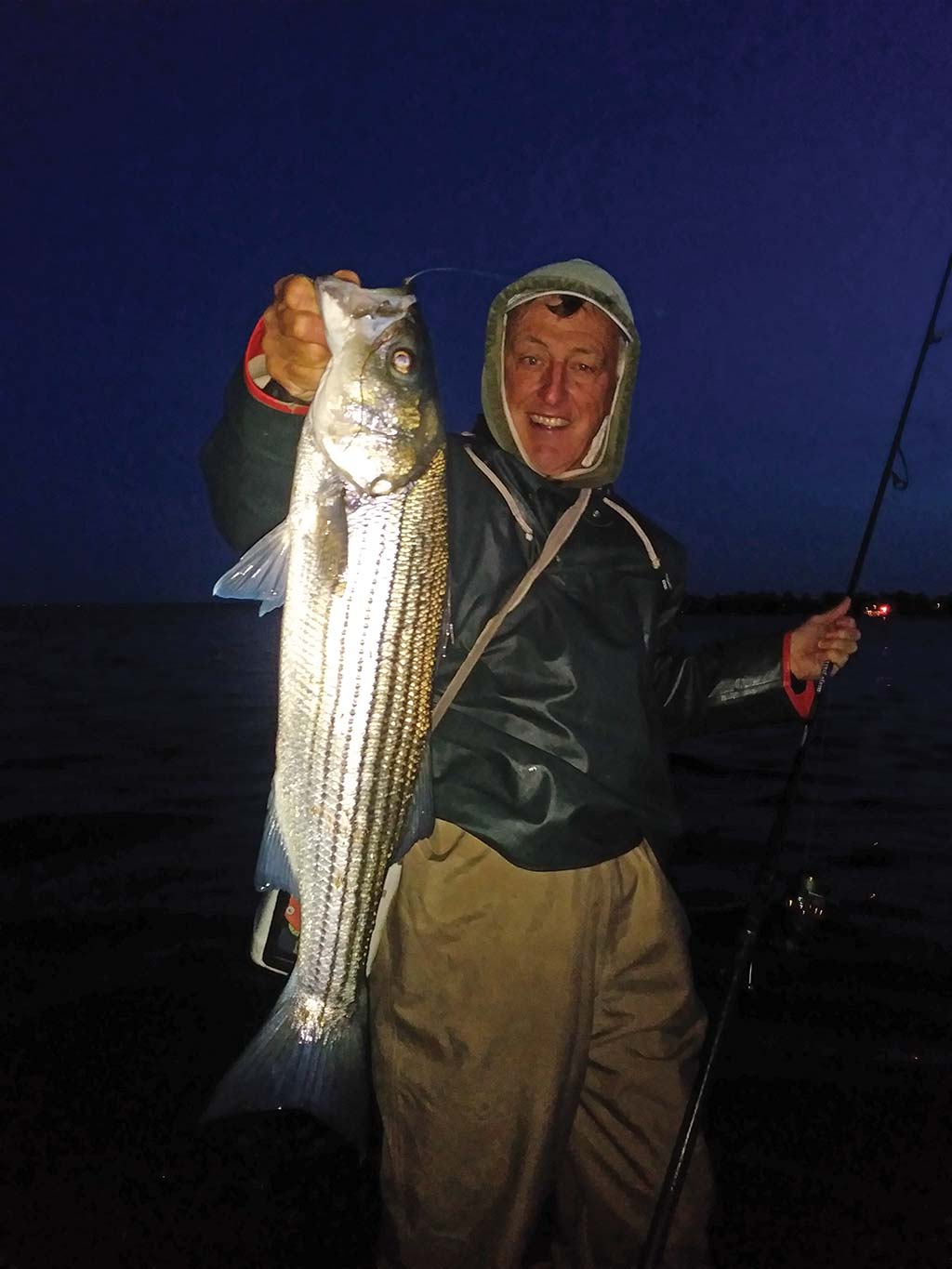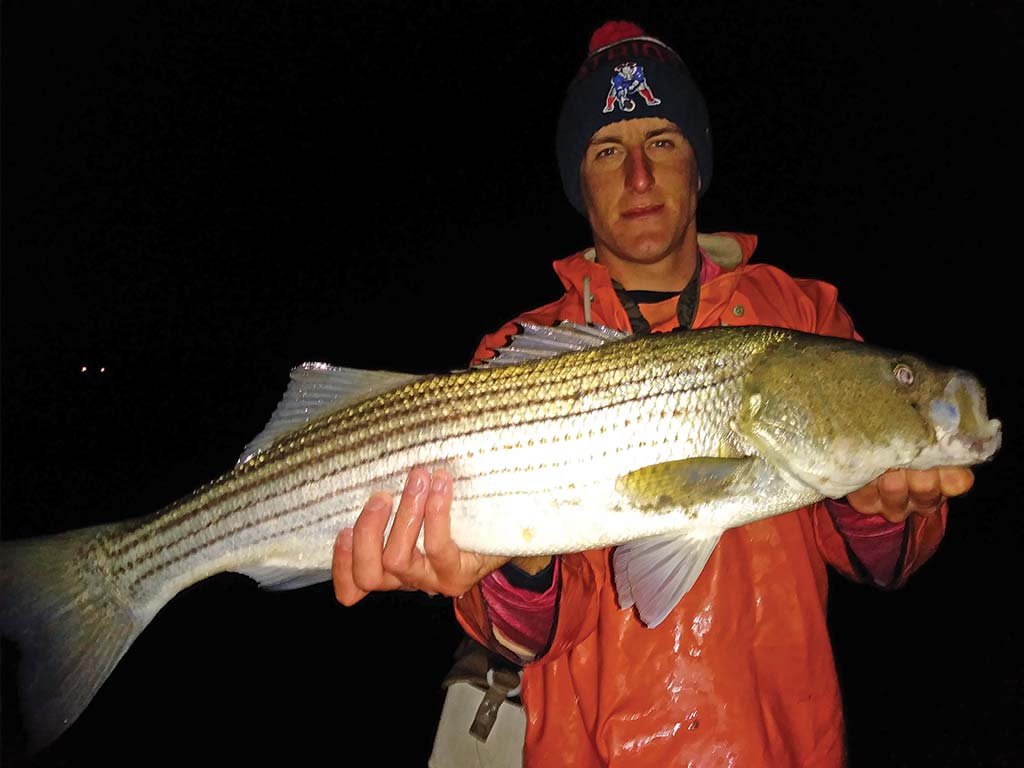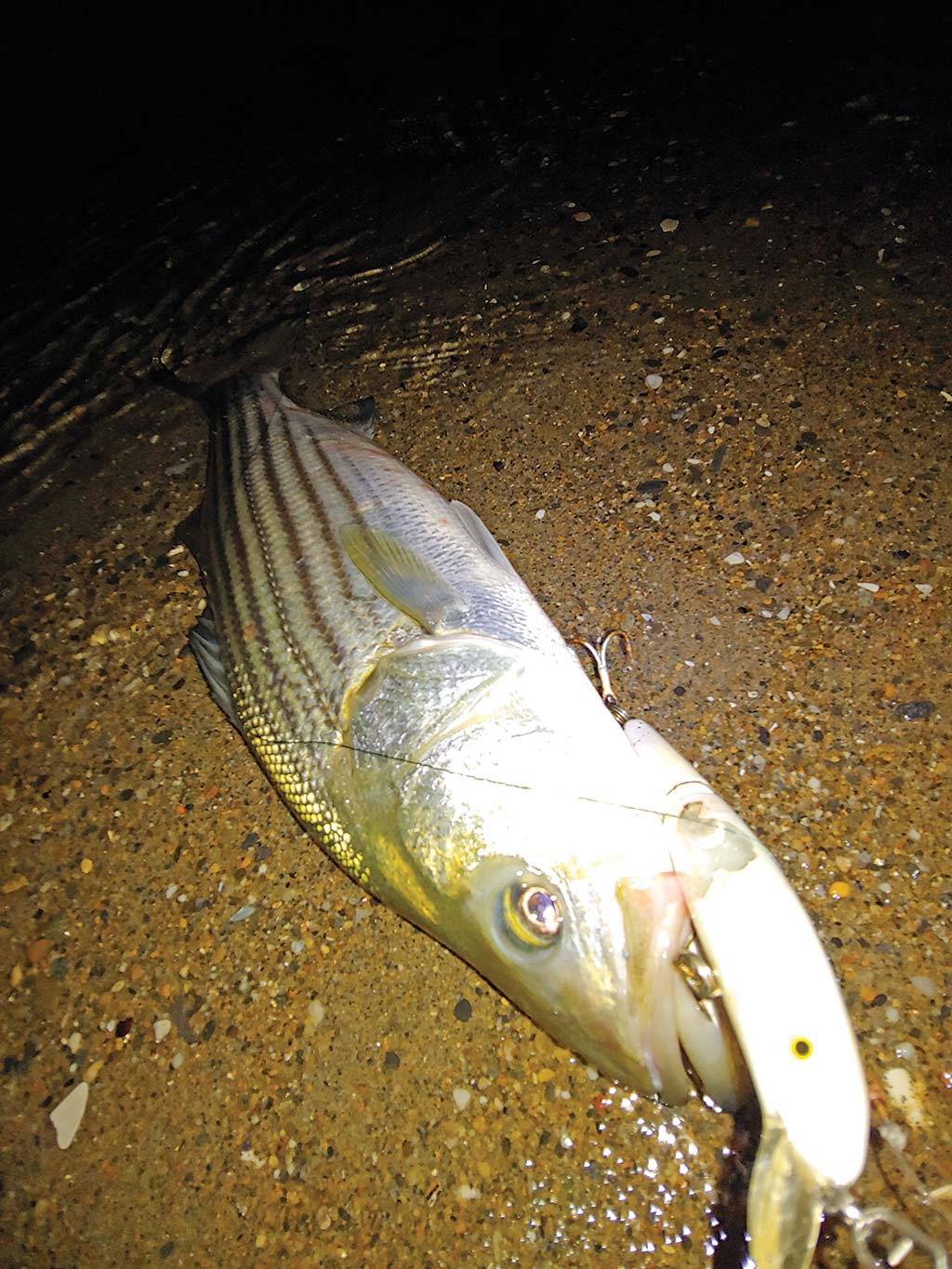
Blitzes are fun and all, but the big fish come out after dark!
Last November, my son Ben and I hit a massive daytime blitz of stripers along one of Rhode Island’s south shore beaches. We were not alone in the afternoon madness as a mile long picket fence of surfcasters were casting into the mayhem of frantic baitfish, frenzied stripers and diving birds. Yet, as the sun began to set, the action slowly wound down as it usually does in a late fall blitz. Within a short period of time, we went from fish everywhere to nothing, and as the fish seemed to fade out so did the fishermen. At just about dark, we looked around, and we were the only two left on the otherwise deserted beach.
Wait A While
I remember telling my son to “wait awhile, the fish will be back”. I’ve seen this pattern so many times in past years. All out blitzes in the daytime turn to nothing at dark, but the action lights up again once darkness settles in. We would play the nighttime game that evening as we decided to plug our way back to the car in darkness.
The fish were on topwater plugs and jigs in the daytime, but I knew from past experience, those daytime offerings would not cut it after dark. We switched to slower moving, more subtle, light-colored lures. He snapped on a 165 size Sebile Magic Swimmer in “Ghostescent” color while I went with a 7-1/2-inch white Slug-Go. In the past, swimmers and skinny plastic have caught most of my nighttime fish along the beach after dark, and white was always the best color for me.
We proceeded to cast and walk slowly along the beach until we found fish. We steadily picked up stripers all along the beach on the mile long walk back to the car, and we never ran into another fisherman. There were no fish breaking, but still good numbers of fish to be had. And, interestingly, the stripers we landed after dark were bigger than the smaller fish we landed in the daylight. We had several slot limit keepers on that walk back to the lot while all the fish in the daylight were schoolies. That is the way it often works on fall nights.
Most surf fishermen who plug the Rhode Island south shore beaches in the daylight for stripers make the mistake of leaving at dark. I suppose many have had their fill of fish after a daytime blitz, and I also know that many fishermen are not comfortable when fishing in complete darkness. It can also be mighty cold along the beach on a late fall night.

Battle Plan
Here’s is my strategy for late fall nighttime striper fishing along this fabled beachfront. Without question, if there is a blitz in the area before dark, I will plug that spot after dark. If you have the bait and you have the fish in the daylight, you can assume at least some fish will remain after dark. No fish along the beach in the daytime will cause me to hit moving water after dark where there is always some activity. I’m talking breachways or outflows that drain several large salt ponds along the south shore. Finally, if the tide is not right or nothing is around the breachways, I might look for structure to try such as boulder fields, mussel bedded bars, or rocky points which abound along this stretch. Stripers love to poke their noses into these high percentage spots after dark in search of food.
The south shore beaches provide the easiest places to fish on a fall night. One interesting fact about beaches is that they all tend to look the same with a continuous line of sand. But, their fish-luring secrets lie hidden beneath the surface. There will be places that are more productive than other spots. Look for places where the water might move differently. Underwater structure like holes, troughs, drop-offs, big rocks and humps are all places where the water might move differently and give away the presence of beach structure. These high percentage places are where bait might collect and stripers might be foraging.
When plugging a nighttime beach, really focus on the wash, that area right in back of where the waves are breaking. Most of Rhody’s beaches have a lip, a spot where the shoreline might dip a foot or two. It is that spot, so close to shore where many fish can be found. That spot will also produce the most turbulence and drag on your plug. I love to just hold a swimmer right behind a wave in the trough and let the pull of the undertow produce the action on the plug. It is one of the key spots to catch stripers at night along the beach.

Breachway Bassing
Many of the sharpies that fish regularly on late fall nights seek out the moving waters of the breachways. These places on the outgoing tides tend to produce a more consistent nighttime game. While these places can be productive, they are often really crowded especially at the tip of the jetty, where the backwater exits into the ocean. Surfcasters may go into a casting rotation in these spots. Other fishermen who don’t want to deal with the chaos off the end of the breachway might find good numbers of fish within the fast moving water inside the breachway itself.
Swimmers are perfect for breachway flows. Cast them into the moving water and simply hold them or reel slowly. You’ll feel the pulsating movement of the swimmer in your rod tip as it swims back and forth against the moving water. I especially like to use plastic swimmers such as Daiwa SP Minnows, Yo-Zuri Hydo Minnows, Bombers and Red Fins. I tend to use the straight back swimmers in water of moderate depth and will use jointed swimmers in shallow water. Light colors tend to be the best. Other fishermen might opt for big wooden metal lip swimmers or darters.
Consider crushing the barbs on the trebles of plugs mentioned above for easier catch-and-release. Other sharpies like to toss big bucktail jigs spiced with plastic curly tails or Fat Cow jig strips into the breachway flows as they scratch the bottom in search of fish. The bucks tend to work best where the water is deeper and snag free.
Other fishermen might gravitate to structure at night. They often zoom in on those spots where beachfront sand transitions into rocks and boulders. Some might look for rocky bars or boulder fields where big stripers tend to forage at night. These areas will be tough to walk through and tough to fish at night and that is why many fishermen avoid them. Swimmers, skinny plastic and needlefish plugs work well in these spots. Live eels are also a popular choice for those who want to toss the real thing.
Along the Rhode Island oceanfront we have over 20 miles of very accessible shoreline from Point Judith to Watch Hill. While most of this beachfront is sand, there are also multiple breachways (outflows), stretches of rocky shoreline, bars and boulder fields. It is an area that sees big numbers of late fall fishermen especially when the visible daytime blitzes are happening. Nighttime, though, sees few fishermen along this 20-mile stretch except for the sharpies working the breachways. One approach would be to focus on those places where the daytime blitzes occurred, and you are likely to be rewarded with great fishing after dark minus the crowds. The other approach would be to seek structure or moving water along this shorefront. Either way, expect to find catch bigger fish after dark.





